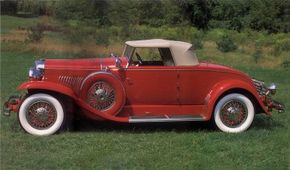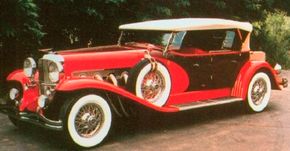At the opening of the New York Salon, on December 1, 1928, one car stood out above all the others that were on display. It was the new Duesenberg. Keep reading to learn more about 1928-1934 Duesenberg J-Series.
Advertisement
The Duesenberg J-101 was the very first of the J-Series cars and the only example that had been completed by December of 1928. And what a gorgeous machine to behold! Finished in silver and black, it was a dual-cowl phaeton, bearing coachwork by LeBaron, The price wasn't specified, except to say that the bare chassis sold for $8,500. Figure at least $2,500 for a coachbuilt body and a buyer would have been looking at a price tag equivalent to 22 Model A Fords.
Left to his own devices, Fred Duesenberg would never have produced anything so pretentious. But financial problems had overtaken the Duesenberg Motor Company of Indianapolis, and control of the firm had been acquired in 1926 by Errett Lobban Cord, president of the Auburn Automobile Company. Cord wisely left Fred Duesenberg and his brother, August, in charge -- but he made it clear that he wanted the Duesenbergs to develop the "World's Greatest Motor Car."
Fred Duesenberg had been building automobiles of his own design as early as 1906, though in those days the name of his backer, Edward R. Mason, appeared on the radiator badge. He had gone on to build marine engines, and marvelously successful racing machines powered by a four-cylinder "walking beam" engine of his own design. Then, during World War I, Duesenberg turned to the production of aircraft engines and powerplants for artillery tractor units.
And finally, in 1921, the first Duesenberg passenger car appeared, the Model A. A highly advanced machine, it was powered by America's first series-produced straight eight, a 259.6-cubic-inch job featuring an overhead camshaft and rated at 88 horsepower. This at a time when Cadillac advertised its fine V-8 at 60 bhp. Speeds as high as 85 miles an hour were possible for anyone foolhardy enough to drive at such a pace on the comparatively primitive roads of the day. And to assure the driver that the Duesenberg would stop as well as it would go, four-wheel hydraulic brakes were fitted-another industry "first."
But at $6,500, that original Duesenberg was an expensive automobile, more than twice as costly as a Cadillac. Demand was never high, and by 1926 production was down to one or two cars a week. It was at that point that E.L. Cord entered the picture, and work commenced on the development of the mighty Model J.
Keep reading to learn about the mechanics behind the Duesenberg J.
Want more information on cars? See:
- Classic Cars
- Muscle Cars
- Sports Cars
- Consumer Auto Guide
- Consumer Auto Guide Used Car Search
Advertisement


